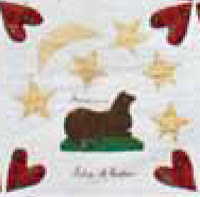I came across an album quilt in an online newsletter from the Orangetown Museum in Rockland County, New York, which featured a quilt from their collection made for Elizabeth Griffiths in 1852. It's an album sampler, not too important in its style or appearance but important to the museum because of who Elizabeth's great-grandson grew up to be---the painter Edward Hopper.
The quilt was made by 62 friends, probably members of the Middletown Baptist Church where Elizabeth's husband Joseph was pastor. The quilt has additional importance to quilt historians because Eliza Cooper, one of the makers, wrote a poem for the presentation that remains with the quilt.
She described many of the blocks with a key and attaches symbolism and meaning to some of the images---something we rarely find written down.
It caught my eye because I have been keeping a file of dogs on quilts and this particular quilt has a dog carrying a basket. And she describes this block!
"Little, Miss Mary Van Houten
Made a dog, would set you shouting,
He is going with his basket, quiet
I do not think, he means to try it."
Dang!---no deep meaning. A good dog carrying a basket [full of something edible?] and he is not going to try it. (Highly unlikely around here.)
Most of the described blocks have a similar lack of profundity beyond the obvious. For the lamb along the bottom:
"You will find a lamb living innocently
By this Julia Cooper’s name you will see
The moon is shining clear and bright
And stars the signal of a clear night."
[The poem has a row and block number assigned to each verse but I can't figure out her system. I am just going by the visuals.]
Here is some symbolism:
"Then the one by Mrs. Sarah Haring
Has a flower like the rose of Sharon,
Also a pitcher, let up fill our glass
And let us have the Maine law come to pass."
The Maine Law was a temperance law---I think we can interpret this as a water pitcher symbolizing support for temperance. And I was also impressed that she called the flower---the typical flat rose---a rose of sharon, a description we use today.
There is a verse that gives some insight into the rules---made to be broken I guess.
"And Mrs. Hope she done her best
But it is not as pretty as the rest,
Curtain calico broke the pledge
So you will find it by the edge."
I am guessing the offender is the above bird perched in chintz leaves----"curtain calico?" Did the organizers say "No chintz---No curtain calico---It's old fashioned. We are modern quilters."
And poor Mrs. Hope, who forgot to read the memo, to be forever insulted in the poem.
See the newsletter with the quilt and the poem here
The Museum is in Pearl River, New York.






There may indeed be a big meaning in the lack of meaning found in the poems.... and that is perhaps in this age we try to put too much significance to things on old quilts.
ReplyDeleteIsn't doggerel just right for this quilt? I'm punning, but I think maybe the verse was just meant to include everyone and be funny. I do hope the lady with the curtain chintz was good humored. Otherwise one might wonder about the Christian good will of this group. I can't tell from my tiny screen, but were all the other blocks solids and the markings on the dog draw by pen and not in the fabric? Another fabulous New York quilt from Baptist quilters around 1852. Duly noted & thanks.
ReplyDeleteThat is funny, love the poems they added to it.
ReplyDeleteI will have to keep my eyes open for quilts with dogs when we take some trips up north.
Debbie
Thanks for sharing this, I enjoyed it very much!
ReplyDelete